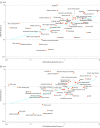Allocation of National Institutes of Health Funding by Disease Category in 2008 and 2019
- PMID: 33502486
- PMCID: PMC7841468
- DOI: 10.1001/jamanetworkopen.2020.34890
Allocation of National Institutes of Health Funding by Disease Category in 2008 and 2019
Abstract
Importance: Prior research suggests an association between burden of disease and National Institutes of Health (NIH) funding. The allocation of NIH funding should reflect, to some extent, the health needs of the population, along with other factors.
Objective: To examine the factors associated with NIH funding in 2019 for 46 diseases.
Design, setting, and participants: This cohort study used disability-adjusted life-years to measure the 2008 and 2019 US burden of disease and compared them with NIH categoric funding for 46 diseases.
Exposures: Disability-adjusted life-years to measure the 2008 and 2019 US burden of disease, 2016 health spending, and 2008 NIH funding levels for 46 diseases.
Main outcomes and measures: 2019 NIH funding levels for 46 diseases.
Results: The 46 diseases accounted for 62 392 713 of 94 399 784 disability-adjusted life-years (66.1%) in 2008 and 75 706 718 of 111 074 472 disability-adjusted life-years (68.2%) in 2019, representing more than 66% of all disability-adjusted life-years in both years. By dollar volume, Alzheimer and dementia increased the most, with approximately $1.8 billion more funding in 2019 than 2008 (from $530 million in 2008 to $2398 million in 2019, a 352% increase), whereas interpersonal violence had the greatest decrease, $95 million, in 2019 NIH funding (from $236 million in 2008 to $141 million in 2019, a 40% decrease). For the 46 diseases in this study, the variable with the greatest association with NIH funding in 2019 was the level of NIH funding in 2008, with a simple correlation of 0.88. Burden of disease and changes in burden of disease were not statistically significantly associated with NIH funding levels once the prior level of funding was included in the model. The models suggested that a 1% higher level of NIH funding in 2008 was associated with a 0.91% higher level of NIH funding in 2019.
Conclusions and relevance: In this study, NIH spending for most diseases seemed to be based primarily on the level of NIH spending more than 10 years earlier, despite changes in burden of disease. Congress and the NIH should examine the allocation process to ensure NIH investments are responsive to changes in the health of the population.
Conflict of interest statement
Figures


References
-
- National Institutes of Health. Mission and goals. Published October 31, 2014. Accessed July 6, 2020. https://www.nih.gov/about-nih/what-we-do/mission-goals
-
- Atkinson RD. Healthy Funding: The Critical Role of Investing in NIH to Boost Health and Lower Costs. Information Technology and Innovation Foundation; 2019. Accessed June 26, 2020. https://itif.org/publications/2019/03/25/healthy-funding-critical-role-i...
Publication types
MeSH terms
Grants and funding
LinkOut - more resources
Full Text Sources
Other Literature Sources

